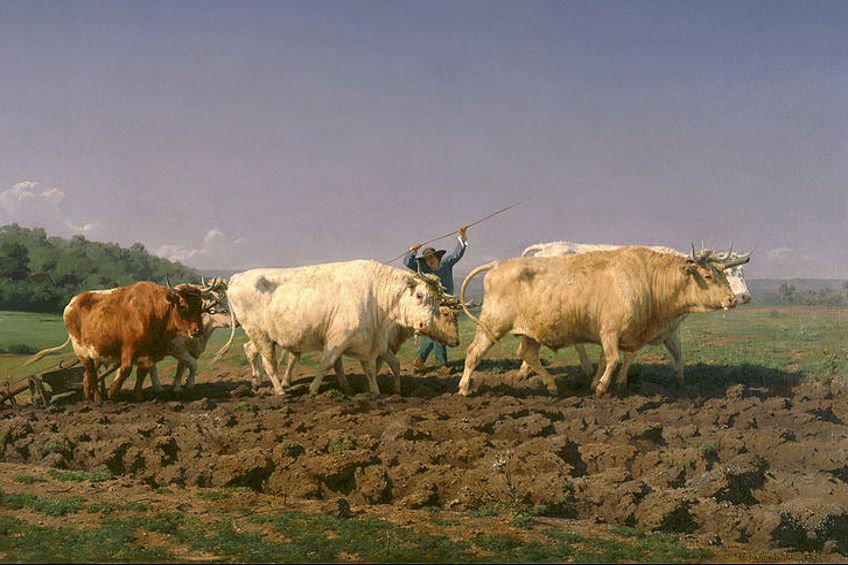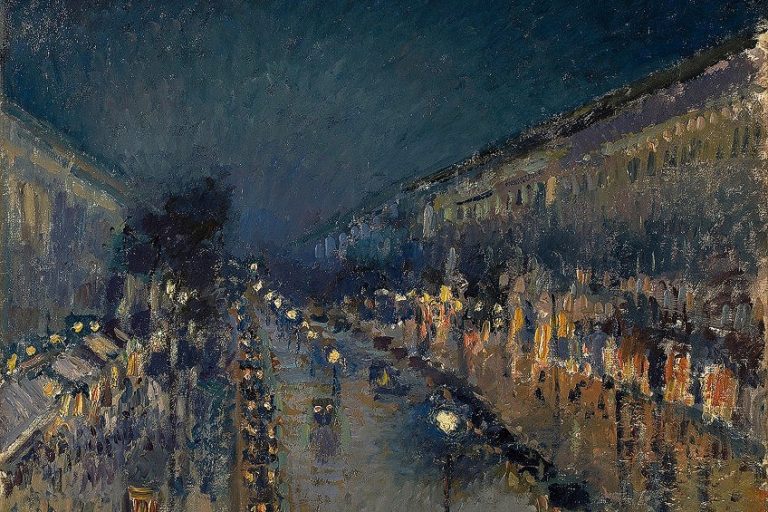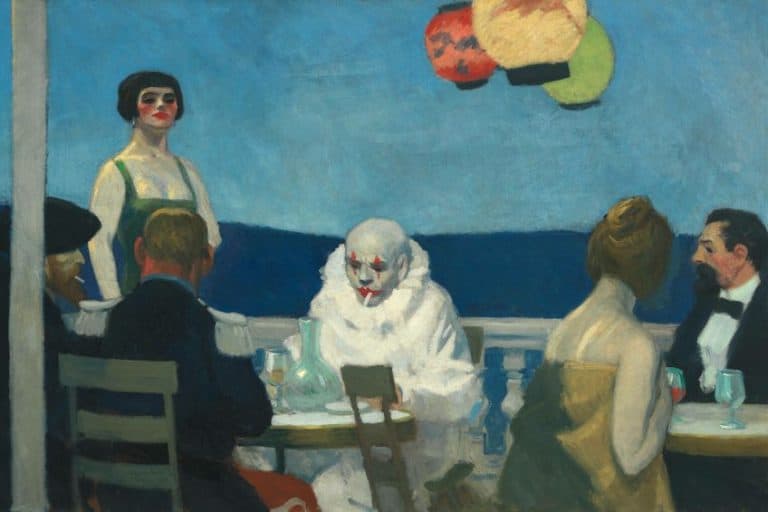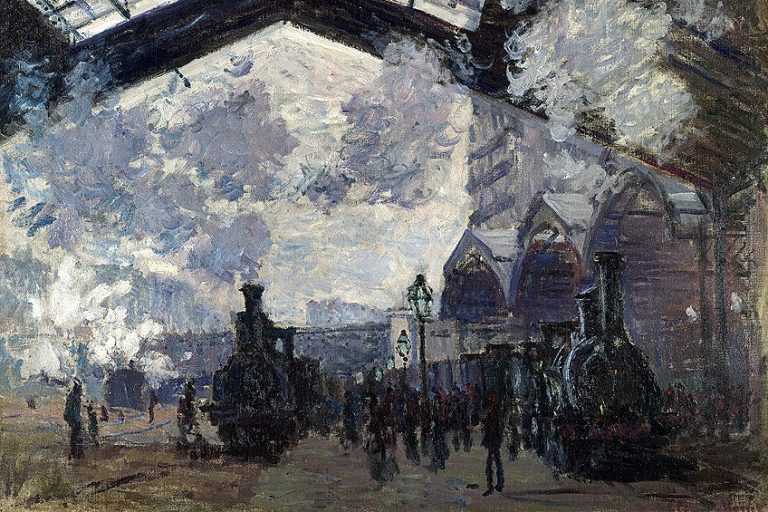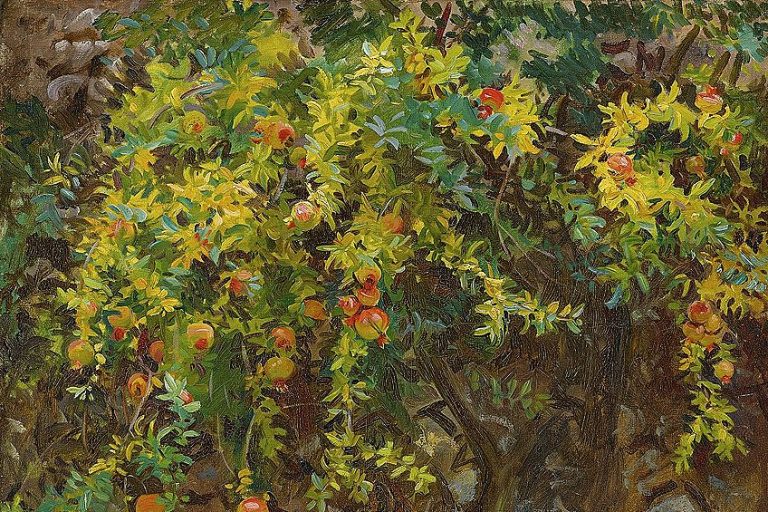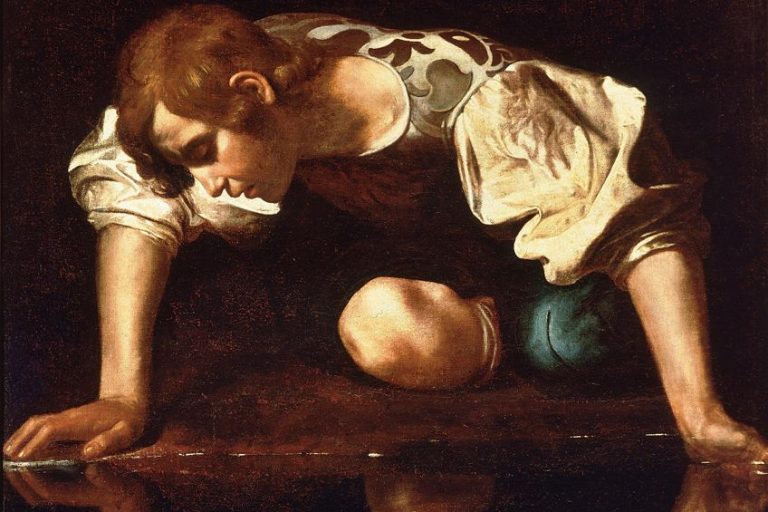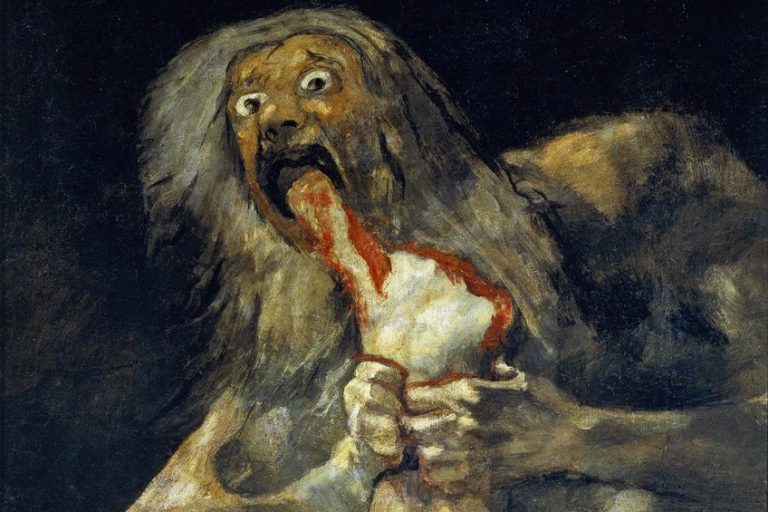Realism Paintings and Artists – Highlights of the Realism Movement
Realism was a 19th century art movement that originated in France and outwardly rejected the previous art movement, Romanticism, since it no longer accurately captured society. After the French revolution, artists began searching for an art style that was able to faithfully represent Contemporary subjects and concepts truthfully, with the techniques and elements of Realism offering just that. Many artists went on to adopt the Realism movement, which led to many famous artworks from this period. In this article, we will review some of the best Realism paintings and artists who shaped the movement, including a brief history on what the movement stood for. Keep reading for more about this revolutionary movement!
Table of Contents
- 1 What Did the Realism Movement Stand For?
- 2 Key Elements of the Realist Movement
- 3 15 Most Famous Realist Paintings and Artists of All Time
- 3.1 The Stone Breakers (1849) by Gustave Courbet
- 3.2 Ploughing in the Nivernais (1849) by Rosa Bonheur
- 3.3 A Burial at Ornans (1849 – 1850) by Gustave Courbet
- 3.4 The Horse Fair (1852 – 1855) by Rosa Bonheur
- 3.5 La Rencontre (Bonjour Monsieur Courbet) (1854) by Gustave Courbet
- 3.6 The Gleaners (1857) by Jean-François Millet
- 3.7 The Angelus (1857 – 1859) by Jean-François Millet
- 3.8 The Old Musician (1862) by Édouard Manet
- 3.9 The Third-Class Carriage (1862 – 1864) by Honoré Daumier
- 3.10 Olympia (1863) by Édouard Manet
- 3.11 Barge Haulers on the Volga (1870 – 1873) by Ilya Repin
- 3.12 Whistler’s Mother (1871) by James McNeill Whistler
- 3.13 The Gross Clinic (1875) by Thomas Eakins
- 3.14 Nighthawks (1942) by Edward Hopper
- 3.15 Christina’s World (1948) by Andrew Wyeth
- 4 Frequently Asked Questions
What Did the Realism Movement Stand For?
Existing primarily as a French art movement, Realism emerged in the 1850s following the 1848 French Revolution. Sometimes referred to as “Naturalism”, this artistic style focused on representing subjects as accurately as possible, while avoiding all hints of artificiality, fantasy, and unearthly elements that were previously in demand in the art world.
Realism was recognized as a response to history painting and Romanticism in the mid-19th century and was characterized by a complete avoidance of stylization, which became increasingly popular in the art periods that followed.
The Industrial Revolution went on to trigger major social changes in its wake, as it firmly established the “right to work” in France. The Realist movement introduced subject matter that featured ordinary and working-class individuals, contemporary settings, and everyday scenes, as subjects that were worthy of being portrayed in art. This led to a greater focus on the realistic aspects that were evident in these areas, as subjects that fell outside of “traditional high art” was suddenly considered valuable.
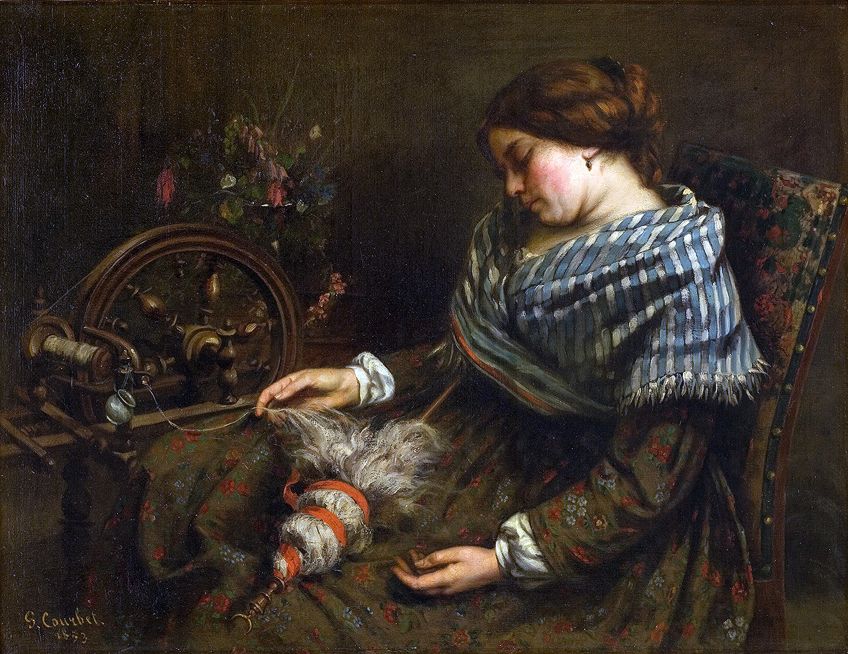
As society adjusted to these changes, artists felt that a different art form was needed to portray this new phase of life, instead of simply enhancing scenes that distorted reality. Realism was characterized by an unprecedented attention to common subjects, which completely transformed the ideals of the Western art world. After its birth in France among famous French painters like Gustave Courbet, Realism and its influence spread to Europe, where it thrived throughout the 19th century.
Realism rebelled against outlandish content and overstated emotions, opting to emphasize the existence of common laborers and regular people, who were engaged in tangible activities relating to the real world.
In addition to focusing on more naturalistic aspects of life, artists who practiced the Realist style fully abandoned all standards associated with the Romantic movement. Prior to the development of Realism, Romanticism dominated French literature and art since the late-18th century until the 1840s. While Romantic works were defined by a heightened sense of emotion, allegorical figures, and grand scenes of nature, Realism artists sought to portray their subject matter and landscapes exactly as they were perceived.
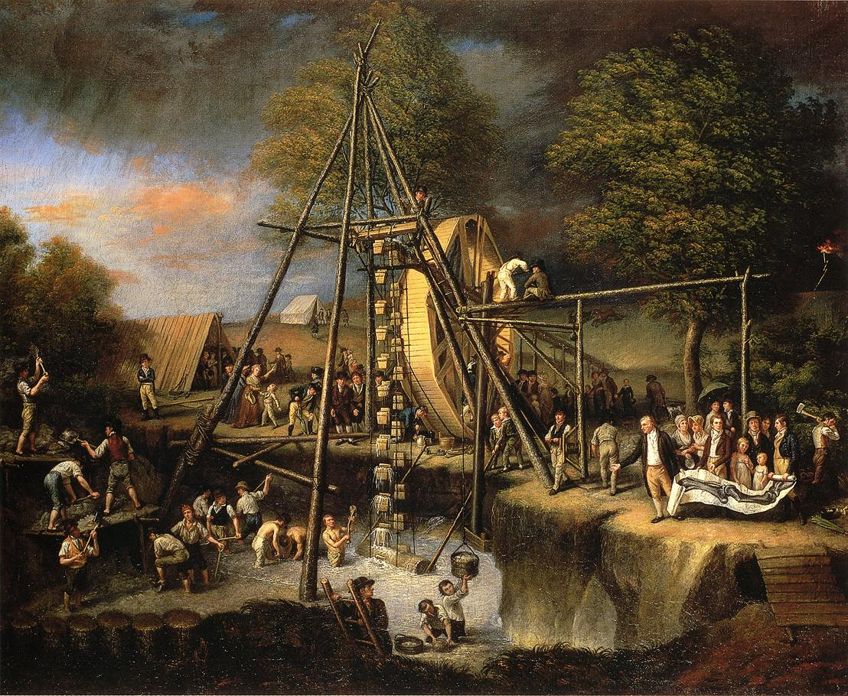
Realism focused on the individuals and areas that were previously ignored in other art styles and genres, and went so far as to portray even the most unpleasant and sordid aspects of life. Thus, Realist paintings were a true reflection of the changes that had occurred in society, as they informed the general public about shifts that would otherwise have not been brought to light. This led to many critics brandishing these artworks as crude, as their frank sense of certainty was often uncomfortable to look at.
Realism was a subtle but incredibly direct departure from the Romanticism movement, as life was no longer glorified in the paintings produced. While the interest in the seemingly ordinary aspects of life might not be as noteworthy today, Realism signified a major shift in the history of art. Other artists such as Winslow Homer depicted European life in its unadulterated context to capture the true experience of how events like war impacted society.
Of all the artists who practiced within this movement, only a few proved to be notable. These artists included French painters like Gustave Courbet, Honoré Daumier, and Jean-Francois Millet.
Key Elements of the Realist Movement
Focusing on contemporary subjects and settings, Realist artists attempted to depict people of all social classes in the same light, so that one group was not favored over another. Images that lent themselves to classical idealism, drama, and any form of sentimentalism were largely avoided. Rather, chaotic aspects of life were emphasized, as they came off as completely unappealing and removed the element of pretentious beauty altogether.
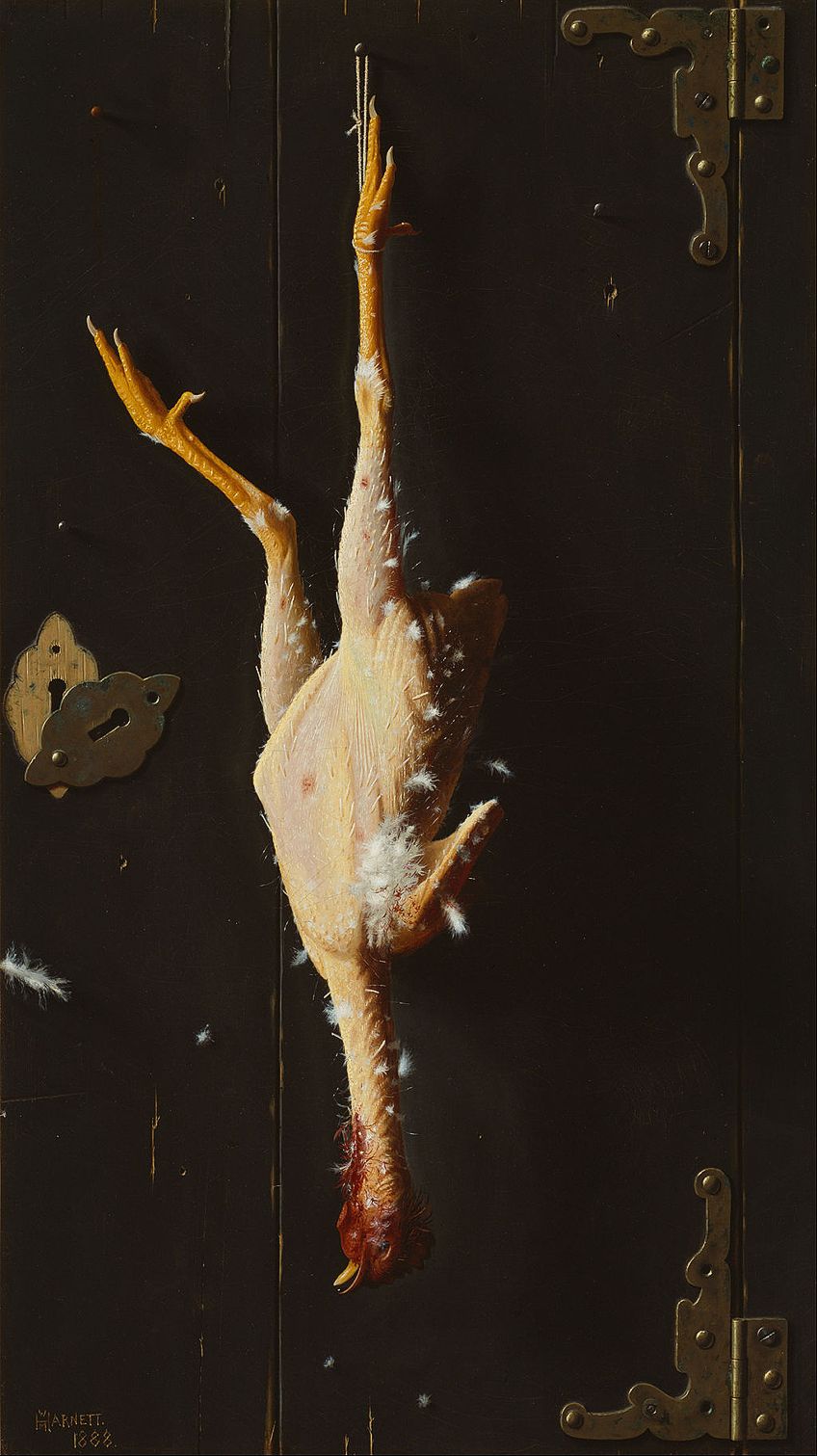
Within the visual art world, Illusionistic Realism was said to depict all forms, perspectives, and precise details such as light and color, in order to create the most accurate image possible. Thus, these naturalist works gave off an illusion of what reality looked like from the 1840s onwards. This period of history was also said to give way to the development of other artistic movements such as American Regionalism, Social Realism, and Kitchen Sink Realism.
The most essential element of Realism was the complete avoidance of artificiality in every aspect of the artworks that were created.
For the first time in art history, human relations and emotions were treated with respect in paintings, as they were allowed to exist truly as they were, without any exaggerated modifications. By attempting to capture a precise and detailed representation of subjects and emotions, Realist artists revolted against the use of exaggeration, as ordinary life was not thought to be so overstated.
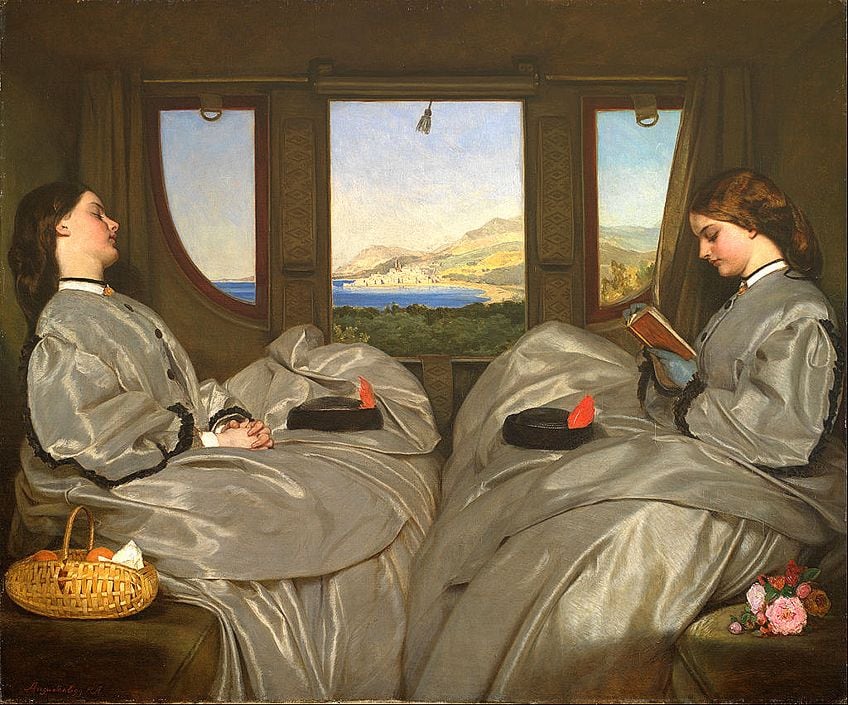
In essence, the subjects chosen by Realism artists demonstrated the social changes that were brought on by the French Revolution. The artistic focus that had previously been reserved for the upper class suddenly shifted to the ordinary lives of common individuals. This was because these individuals were thought to offer the most accurate representation of what life was like during this period, with artists displaying even the most miserable and disordered elements of life in their artworks.
The style of Realism eventually spread to almost all genres of art and went on to influence the emergence of Impressionism. The subjects favored by Realism artists meant that the movement was never fully embraced by upper and middle-class patrons or critics, who viewed the frankness of Realist paintings as shocking and disturbing.
Realism initiated a general move away from the “ideal” representation of life and towards the “ordinary”, as artists felt free to depict real-life that was devoid of superficial aesthetics and “universal truths”.
15 Most Famous Realist Paintings and Artists of All Time
The Realism art movement was an incredibly notable period within art history and is celebrated for its emphasis on the ordinary, which ushered in a new era of artistic exploration. Of all the artworks that were produced in the movement, several Realist paintings stood out above the rest since they helped pioneer the development of the movement and its aesthetics. Below, we will be discussing our top 15 Realism paintings and artists, whose approaches in painting show off the realities of European society throughout the 19th century.
The Stone Breakers (1849) by Gustave Courbet
| Artist | Gustave Courbet (1819 – 1877) |
| Date | 1849 |
| Medium | Oil on canvas |
| Dimensions (cm) | 170 x 240 |
| Where It Is Housed | Destroyed during World War Two |
A painting that encapsulates the ideals of the Realism movement is The Stone Breakers, which was painted by the mid-19th century French painter Gustave Courbet in 1849. As the leader of the Realism group, Courbet was commissioned to paint several artworks, which have all gone on to achieve equal fame during the movement’s height. After exhibiting The Stone Breakers at the Paris Salon in 1850, Courbet received harsh backlash from audiences and critics. However, this reaction was also said to have sparked a major change in the development of Realism.
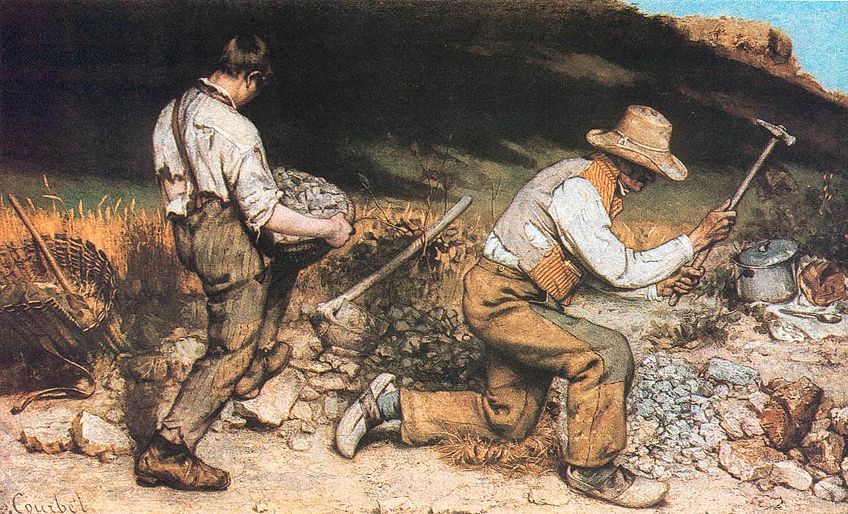
Within The Stone Breakers, Courbet depicted two peasants who appeared to be breaking rocks for the construction of a road. By giving viewers a snapshot into the everyday lives of these workers, Courbet was able to authentically portray a scene from the real world and was thus devoid of grandiosity or romanticization.
With the backs of the laborers turned away from the viewers, Courbet retained the anonymity of the workers, while refusing to focus on the part of the image that would generally draw the most attention.
By depicting a scene that was known to be physically demanding and severely underpaid, with the faces of the individuals hidden, Courbet demonstrated a blatant departure from the long-held customs of traditional painting. More attention was given to the men’s tattered clothing and their relationship to the land, which differed greatly from the type of art that society was used to. The Stone Breakers was criticized as “too common” for the aristocratic society, who often preferred subjects that were worthy of their attention.
Ploughing in the Nivernais (1849) by Rosa Bonheur
| Artist | Rosa Bonheur (1822 – 1899) |
| Date | 1849 |
| Medium | Oil on canvas |
| Dimensions (cm) | 133 x 260 |
| Where It Is Housed | Musée d’Orsay, Paris, France |
One of the most well-known female Realism artists was Rosa Bonheur, who was generally regarded as the most prolific female painter of the 19th century. Her artwork, Ploughing in the Nivernais, painted in 1849, was widely considered to be her best work. Bonheur went on to depict farm animals and rural landscapes in the majority of her paintings, which were commended for the her use of extreme Realism. Ploughing in the Nivernais was commissioned by the French government and went on to win the first medal at that year’s Salon.

According to the painting’s title, Bonheur depicted the first ploughing of the season, which was usually done in early autumn to break up the surface of the soil for winter. In her work, 12 oxen are shown to be peacefully ploughing the land in preparation, yet the focus of the work seems to fall on the tranquility present in the landscape. Ploughing in the Nivernais narrates a gracious story of the unending hardships of a peasant, including their work, life, and traditions. The atmosphere within this painting brings about a humble sense of Realism.
By presenting an image of oxen and men working together to harvest the land, Bonheur comments on the relationship between man and nature.
A seamless scene is depicted where the animals appear as the true heroes of the work, leaving little room for the men to be noticed. Thus, Bonheur’s work exists as a homage to agricultural labor that peasants were required to do, with this common activity being elevated in status due to the attractive scene it sets. Interestingly, this Realism painting was one of the few artworks that drew critical acclaim.
A Burial at Ornans (1849 – 1850) by Gustave Courbet
| Artist | Gustave Courbet (1819 – 1877) |
| Date | 1849 – 1850 |
| Medium | Oil on canvas |
| Dimensions (cm) | 315 x 660 |
| Where It Is Housed | Musée d’Orsay, Paris, France |
A Burial at Ornans, painted between 1849 and 1850, exists as the most celebrated painting completed by Gustave Courbet. Due to its vast size, this artwork drew both acclaim and condemnation from critics and the public when it was initially exhibited, and was criticized for its treatment of a standard provincial funeral. A Burial at Ornans was also heavily criticized for its scale, as a painting this size was traditionally reserved for heroic and religious scenes in Contemporary painting.
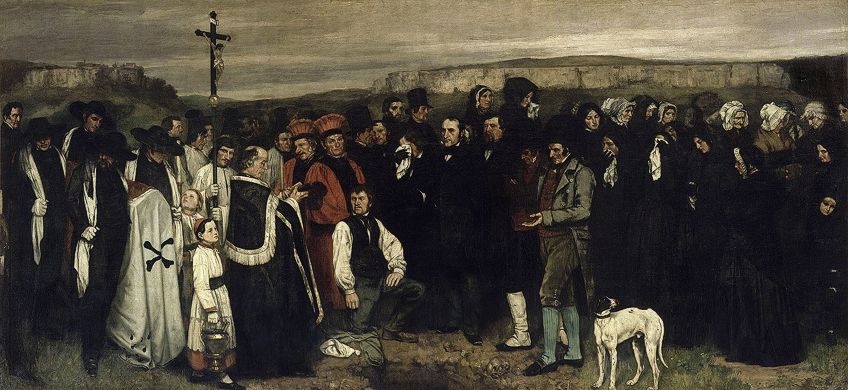
Courbet depicts the 1848 funeral of his great uncle, which took place in Ornans, France in September. Despite representing a somber event, Courbet defied all expectations associated with death by presenting the funeral in a realistic way. Traditionally, these events contained moments of both grief and beauty so that viewers could easily visualize the soul of the departed as gracefully rising toward the heavens. Instead, Courbet placed more emphasis on the mourners, who appear to be paying little to no attention to the priest.
A Burial at Ornans noticeably lacks the sentimentality expected in a genre work like this. By stripping the work of all artificial indications of grief, the faces of the mourners appear more exaggerated in nature, with critics accusing Courbet of deliberately slighting religion by pursuing a sense of unpleasantness in his painting.
Through creating a background made up of several anonymous individuals, Courbet was able to depict something as mundane as a funeral service with unknown individuals, without any spiritual values, and on a grand scale.
The Horse Fair (1852 – 1855) by Rosa Bonheur
| Artist | Rosa Bonheur (1822 – 1899) |
| Date | 1852 – 1855 |
| Medium | Oil on canvas |
| Dimensions (cm) | 244.5 cm x 506.7 |
| Where It Is Housed | The Metropolitan Museum of Art, New York City, United States |
Another famous Rosa Bonheur Realist paintings was The Horse Fair, which was painted between 1852 and 1855. Since the majority of Bonheur’s artworks focused on animals, this painting proves to be no different as the focus is placed on a group of horses in the foreground of the painting. The Horse Fair is widely considered to be the most iconic Realism artwork produced during the movement’s peak. Existing at a monumental size, Bonheur dedicated herself to the study of draft horses for a year.

Disguising herself as a man for a year and a half, so as not to draw attention to herself, Bonheur attended the Boulevard de I’Hôpital horse market in Paris and completed numerous sketches of animals. These drawings featured both simple line drawings, as well as detailed sketches. While Bonheur portrayed dealers, who were busy selling their horses at the market, the true focal point of this painting was the intense power, beauty, and strength of the horses at the scene.
The skillful treatment of movement and the whirl of dark and light surrounding the untamed animals was juxtaposed by the calm handlers, who were leading the horses. Despite this being an incredibly busy painting, Bonheur was able to balance the motion in the middle with the simplicity and stillness that can be seen in the foreground.
This painting proved to be very popular and was praised for its flawless details on both the horses and the riders, such that it went on to garner universal fame after its exhibition at the 1853 Salon.
La Rencontre (Bonjour Monsieur Courbet) (1854) by Gustave Courbet
| Artist | Gustave Courbet (1819 – 1877) |
| Date | 1854 |
| Medium | Oil on canvas |
| Dimensions (cm) | 129 x 149 |
| Where It Is Housed | Musée Fabre, Montpellier, France |
The final artwork of Gustave Courbet that has been included on this list is La Rencontre (Bonjour Monsieur Courbet), which was painted in 1854. Existing as one of the first paintings to receive the controversial label of “Avant-Garde”, this painting demonstrated Courbet’s willingness to risk his reputation in search of a new method of visual expression. This new method of Realism helped him to break down the old approaches to painting, which can be seen within various elements of La Rencontre.
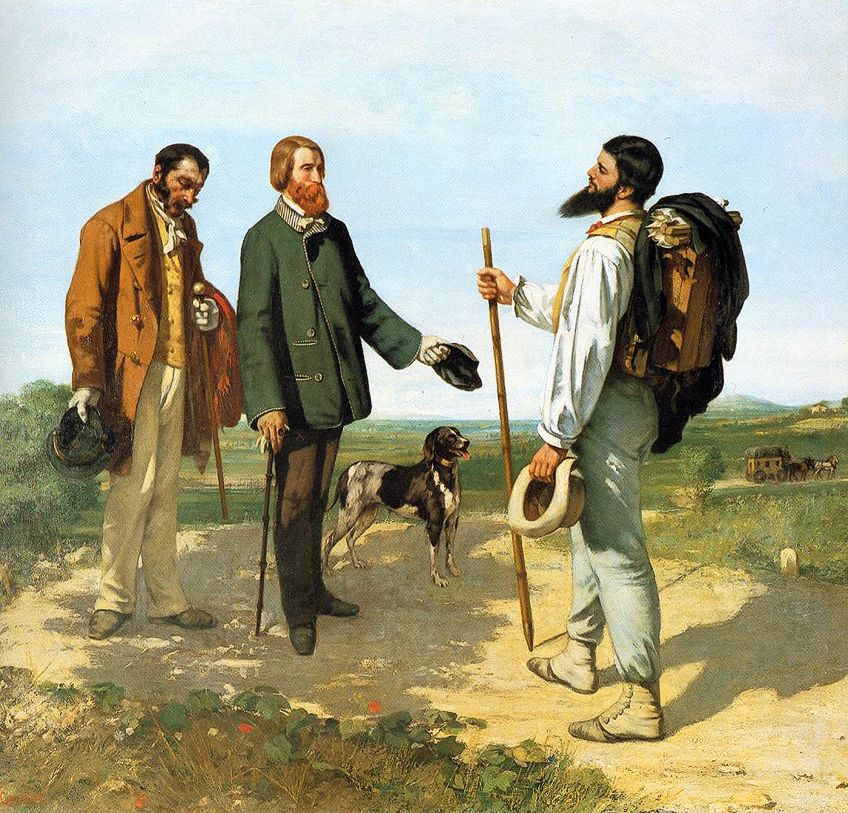
In this large painting, Courbet created a self-portrait by depicting himself on the right side of the canvas meeting with Alfred Bruyas, who was a famous patron and supporter of his work. Depicting himself as a traveling man, who had just come across two noblemen, Courbet emphasized the notion of self-importance in the way he portrayed himself.
By placing himself in the direct light with his head titled slightly back, Courbet implied that the focus of the work should fall to him, with the stick he holds further accentuating his great strength.
La Rencontre is recognized as a famous Courbet painting that reflected his open rejection of previous artistic conventions. Both men in the painting are presented in a countryside setting to paint, which Courbet used to strike a comparison between himself and Alfred Bruyas. Courbet also suggested that he was far superior to Bruyas since he carried all his art supplies in a backpack, while his competitor needed a servant to trail after him with what he needed. Thus, this artwork emphasizes the idea that both Bruyas and viewers of the work were on Courbet’s turf.
The Gleaners (1857) by Jean-François Millet
| Artist | Jean-François Millet (1814 – 1875) |
| Date | 1857 |
| Medium | Oil on canvas |
| Dimensions (cm) | 83.8 x 111.8 |
| Where It Is Housed | Musée d’Orsay, Paris, France |
An artist who was considered to be one of the famous French Realist painters was Jean-Francois Millet. Millet painted The Gleaners in 1857, which is widely considered to be one of the most important works of the Realism movement. While Millet went through a stage of focusing on landscapes, the concept of gleaning repeatedly returned to him for over seven years. Gleaning describes the backbreaking work of removing the bits of grain that were left in the fields after the harvest, with this job falling to women and children.
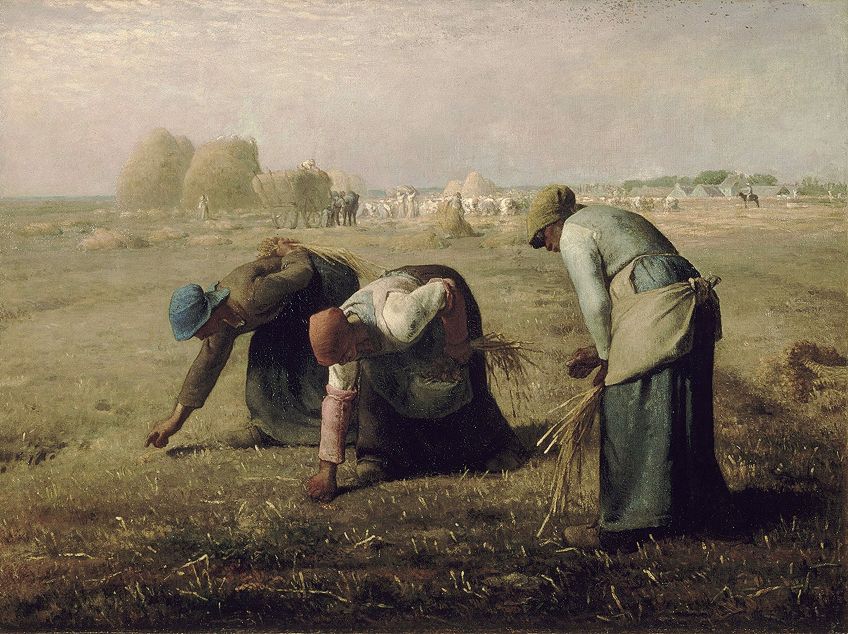
The Gleaners exists as Miller’s best artwork due to its portrayal of the realities of the lower class. Within this painting, he depicted three ordinary women engaged in common activities for the working class. Gleaning was widely considered to fall to the lowest rank of French society at the time and Millet portrayed this laborious work in a way that placed these workers at the forefront of our attention.
In doing so, Millet made a direct statement to the audience to not forget the laborers as an integral part of the workforce, and without their efforts, successful harvests would not usually happen.
Despite their circumstances of poverty, Millet granted a quiet dignity upon the women, who met their task with a strong fortitude despite the monotony of gleaning. Millet viewed the theme of gleaning as an eternal one, which led to him linking The Gleaners to stories taken from the Old Testament. Despite this religious link, his painting proved to be very unpopular when it was first submitted to the Salon in 1857. Its “bland and mundane” subject enraged the public after viewing it, as it was not seen as “worthy of attention”.
The Angelus (1857 – 1859) by Jean-François Millet
| Artist | Jean-François Millet (1814 – 1875) |
| Date | 1857 – 1859 |
| Medium | Oil on canvas |
| Dimensions (cm) | 55.5 x 66 |
| Where It Is Housed | Musée d’Orsay, Paris, France |
Another of Jean-Francois Millet’s best Realist paintings was The Angelus, which he painted between 1857 and 1859. This artwork demonstrated Millet’s desire to shine a light on the lives of the French peasants and the hardships they suffered, and educate aristocratic society about life outside of their social bubbles. This painting was commissioned by art collector Thomas Gold Appleton, however, he never came to collect the work once it had been completed.

Within The Angelus, Millet depicted two farm laborers with their heads bowed in a position of prayer, while reciting The Angelus after a hard day of work in the field. Both individuals appear to be leaning over a basket of potatoes, while the man on the left holds his hat in his hands and the woman on the right has her hands firmly placed in prayer.
“The Angelus” was a well-known prayer for deliverance at the time of Roman Catholicism, with this painting demonstrating a simple act of devotion and prayer for salvation by the lowest class in society.
With the sun setting in this distance, The Angelus marked the moment prayer began, at six in the evening, as a bell would have been heard from the church in the background, signaling the end of the day. Despite their tattered clothes and bowed shoulders, the workers have a quiet dignity about them. This artwork influenced Surrealist Salvador Dalí, who instead saw the workers to be praying over their buried child. In 1963, The Louvre conducted an X-ray scan of the work, which showed a hidden outline of a geometric shape similar to that of a coffin.
The Old Musician (1862) by Édouard Manet
| Artist | Édouard Manet (1832 – 1883) |
| Date | 1862 |
| Medium | Oil on canvas |
| Dimensions (cm) | 187.4 x 248.3 |
| Where It Is Housed | National Gallery of Art, Washington D.C., United States |
Although most often studied within the context of Impressionism, French artist Édouard Manet produced a few notable Realism artifacts during his career. Seen as a pivotal figure in the transition period from Impressionism to Realism, Manet painted with outstanding modernity, which led to him depicting the working class within his Realist paintings. The Old Musician, which he painted in 1862, was the largest painting ever produced by Manet, which noticeably displayed the influence that Gustave Courbet had on his artistic style at the time.
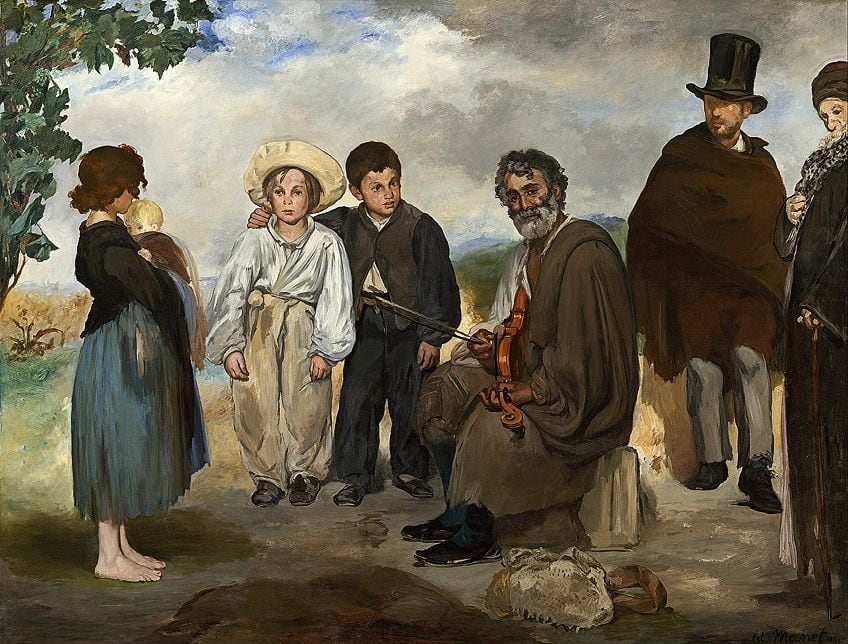
The Old Musician exists as a grand example of Edouard Manet’s ability to capture the impressions of everyday life. The painting depicts several individuals standing around a musician in the center of the work, who is about to play the violin. The musician was speculated to be Jean Lagrène, who was the leader of a local gypsy band at the time.
The individuals pictured in this scene were constantly scrutinized, as none of them seemed to create a cohesive group.
At the very right of the painting, a man wearing a turban and a long robe is shown standing directly opposite a young mother, who appears shoeless with her newborn baby. Considering these two figures, their clothing and subsequent social classes differ greatly, which emphasizes the discord in society. The Old Musician contained a series of references to Manet’s other paintings, such as the man in the top hat, who also appeared in his 1859 painting, The Absinthe Drinker.
The Third-Class Carriage (1862 – 1864) by Honoré Daumier
| Artist | Honoré Daumier (1808 – 1879) |
| Date | 1862 – 1864 |
| Medium | Oil on canvas |
| Dimensions (cm) | 65.4 x 90.2 |
| Where It Is Housed | The Metropolitan Museum of Art, New York City, United States |
Considered to be one of the most famous Realist painters was the French artist Honoré Daumier, who created the series of paintings titled The Third-Class Carriage between 1862 and 1864. Recognized as a graphic painter, Daumier frequently characterized the livelihoods of the lower class and the impact that industrialization had on urban life in France. Daumier painted other train scenes from the first and second-class compartments, yet The Third-Class Carriage proved to be the most influential out of the three works.

A recurrent theme in Daumier’s work is the effect that urbanization had on the working-class of Paris. While paying particular attention to the form of public transport, The Third-Class Carriage places more emphasis on the way that social hierarchy was still enforced in a time that was supposedly modern.
By portraying members of a lower class in the third-class carriage, a scene that was not by any means uncommon, Daumier commented on the social politics that were at play within France.
The individuals within the carriage appear to be exhausted after a long day of work, with the focus of the painting on the figures seated on the wooden bench in the foreground. A soft glow of light seeps in through the window, which further highlights the nursing mother, the old lady, and the sleeping boy, who exude a peacefulness not often associated with traveling on public transport. Wealthier passengers appear to be seated behind them and are separated by a bench that divides the two classes, which further implies the class divisions that existed in France.
Olympia (1863) by Édouard Manet
| Artist | Édouard Manet (1832 – 1883) |
| Date | 1863 |
| Medium | Oil on canvas |
| Dimensions (cm) | 130.5 x 190 |
| Where It Is Housed | Musée d’Orsay, Paris |
Manet’s other notable Realist painting was Olympia, which he painted in 1863. Manet was fond of the female form and went on to depict many female nudes in a few of his artworks. He also tended to focus on the life of French society, which can also be seen in his paintings. Within Olympia, Manet used of his two favorite subjects, as he represented a lower-class prostitute posing in the nude. Due to the supposedly vulgar scene, this work was instantly controversial from the moment it was exhibited.

The woman, whose name was thought to be Olympia, was depicted as lounging on an open bed, in a way that invites viewers to join her. In the background, a maid is seen bringing her flowers, which were probably a gift from a lover. Manet created a stark contrast between these two women not only through their skin color but by the fact that the maid appeared to be fully dressed in her work attire, while the prostitute was completely naked. Despite Olympia’s vulnerability, the woman appears completely at ease with her lack of clothing.
The unashamed and challenging gaze with which the woman addressed viewers was Manet’s way of challenging upper-class society’s hypocritical notions of decency.
Through choosing to depict a prostitute, Manet made a very overt comment on bourgeois society at the time, who preferred to keep such indecent activities under wraps despite it being a well-known part of society. Thus, Olympia was made to be purposefully provocative, as Manet intended to shock viewers at the 1865 Salon, who incidentally flocked to see this painting.
Barge Haulers on the Volga (1870 – 1873) by Ilya Repin
| Artist | Ilya Repin (1844 – 1930) |
| Date | 1870 – 1873 |
| Medium | Oil on canvas |
| Dimensions (cm) | 131.5 x 281 |
| Where It Is Housed | State Russian Museum, St. Petersburg, Russia |
An iconic Russian painter within the Realism movement was Ilya Repin, who went on to paint Barge Haulers on the Volga between 1870 and 1873. Seen as a pioneer of Realism in Russia, Repin was a major advocate for Social Realism, which can be seen in many of his artworks. Barge Haulers on the Volga was viewed as a criticism of the profit of human labor that focused on the difficulties of ordinary sailors and dockworkers in the well-known ports along the Volga River during the late 19th century.
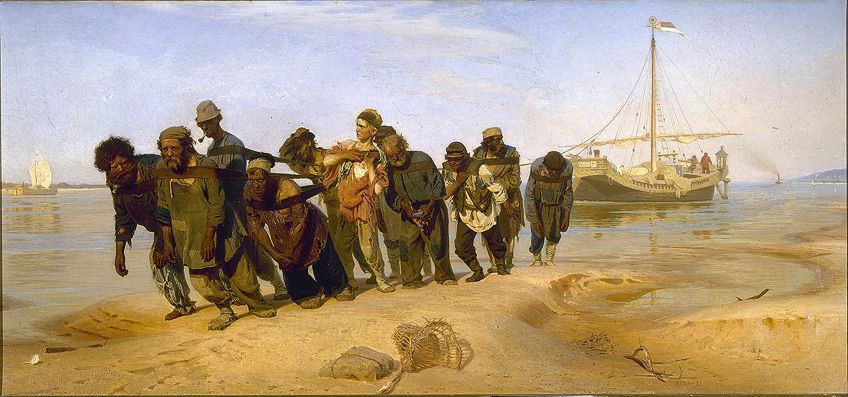
Spending months sitting alongside the Volga River and documenting the ships and their hardworking sailors, Repin painted Barge Haulers on the Volga after many preparatory sketches. This allowed him to create an accurate portrayal of the working conditions of these seamen, who vigorously toiled onboard the decks every day. In this work, Repin depicted 11 male haulers of different ethnic backgrounds, slowly pulling a barge upstream on the Volga River.
The physical exhaustion is evident in the way the men appear to walk, as they are doubled over from fatigue. The warmer tones of the river bank contrast against their weathered skin and the dark shadows provided by their silhouettes. Only one man stands out from the group due to his brightly colored clothing and his youthful look. He is shown to be more upright than his fellow workers, as he seems to be unburdening himself from his binds.
This motion captured the spirit of protest against exploitation and the return of dignity among sea laborers.
Whistler’s Mother (1871) by James McNeill Whistler
| Artist | James McNeill Whistler (1834 – 1903) |
| Date | 1871 |
| Medium | Oil on canvas |
| Dimensions (cm) | 144.3 x 162.4 |
| Where It Is Housed | Musée d’Orsay, Paris, France |
American painter James McNeill Whistler was most famous for his abandonment of Realism in favor of developing his own style in modern painting. His most notable work was painted in 1871, titled Whistler’s Mother, although it is also identified as Arrangement in Grey and Black No. 1. The painting features his mother as his focal subject and went on to become the first American work that was purchased by the French government in 1891. This greatly elevated Whistler’s reputation as an artist and secured him many wealthy American patrons.

Whistler’s Mother appears grim and serious at first glance, but art critics and audiences have remained fascinated throughout the years by Whistler’s ability to portray his mother in such a high level of detail. Clothed in a long black dress and a white lace cap, it remains unclear if his mother was in mourning or simply wearing a modest outfit that was in keeping with the fashion preferences of the late 19th century.
Seated in profile, “Whistler’s Mother” was dubbed “The American Mona Lisa”, as it contained the same level of secrecy and skill as the famous Leonardo da Vinci painting, “Mona Lisa” (1503).
Living with his mother at the time, Whistler asked his mother to pose for him after a model canceled a scheduled session. His mother was 67 years old at the time, so, Whistler modified his composition to accommodate for his mother’s comfort. Interpreted as a symbol for motherhood, Whistler’s Mother exists as an important painting, which was also one of the few works that was appreciated by the bourgeois society, while resonating with the masses.
The Gross Clinic (1875) by Thomas Eakins
| Artist | Thomas Eakins (1844 – 1916) |
| Date | 1875 |
| Medium | Oil on canvas |
| Dimensions (cm) | 240 x 200 |
| Where It Is Housed | Philadelphia Museum of Art, Philadelphia, United States |
Thomas Eakins was among the most famous Realism artists, who painted The Gross Clinic in 1875. During the mid-1800s, many medical developments emerged, which helped lead the way towards the innovations that changed the world. Eakins displayed a great fascination with medicine during this time, with his work existing as a snapshot of a lecture taking place at Jefferson Medical College. Throughout time, The Gross Clinic has been referred to as one of the best American paintings to exist.
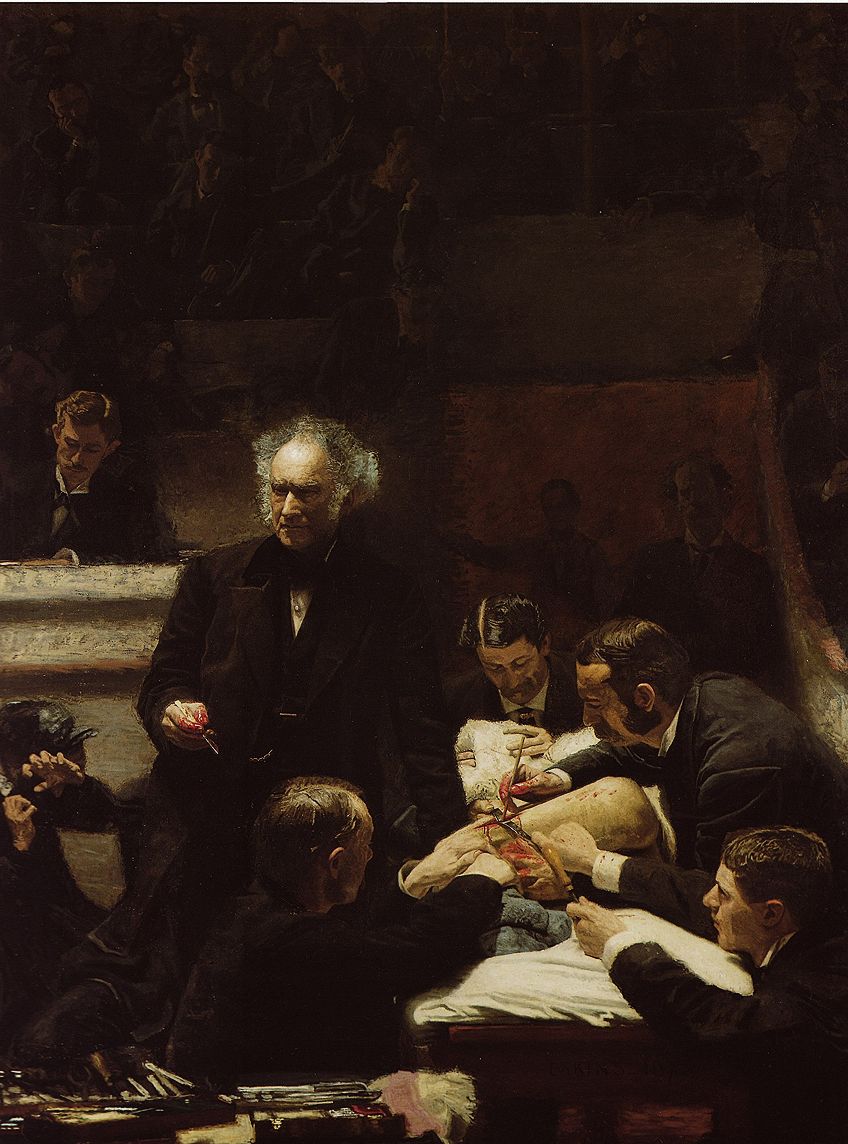
Known as one of the chief medical institutes in the world during the 1800s, Eakins captured a lesson hosted by Dr. Samuel D. Gross, who was 70 years old at the time. Dressed in a black coat, Gross is seen in the middle of the composition, while he presumably gives a lecture about the surgery that was currently taking place next to him to a room full of eager students. Over Gross’ shoulder, to the right of the work, is his clinic clerk Dr. Franklin West, who was taking notes of the orthopedic operation underway.
In the top left corner, Eakins inserted himself in the audience. This was said to be influenced by his own anatomy and dissection courses, as he paid great attention to the details of the surgery. Displaying great artistic skill, the scientific effort of this painting was acutely contrasted against the emotional reaction of the only woman present, in the bottom left corner.
“The Gross Clinic” was viewed with scrutiny due to its unsightly nature, as audiences struggled to comprehend the sheer presence of reality within the work.
Nighthawks (1942) by Edward Hopper
| Artist | Edward Hopper (1882 – 1967) |
| Date | 1942 |
| Medium | Oil on canvas |
| Dimensions (cm) | 84.1 x 152.4 |
| Where It Is Housed | Art Institute of Chicago, Illinois, United States |
Painted in 1942, almost a century after the Realism movement reached its peak, Nighthawks is still considered to be an important Realist painting. American artist Edward Hopper was well-known for his use of Realism, as the overall style of the genre had changed very little despite the time that had passed. Nighthawks is considered to be one of the most recognizable American paintings to ever be created, as it depicts a typical scene within America during the post-World War II era.
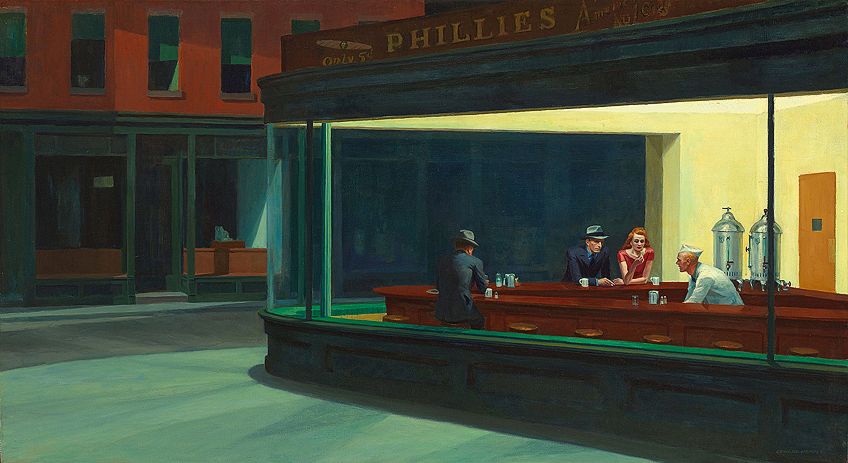
During the 1940s, industrialization transformed life in the Westernized world. In Hopper’s painting, he portrayed four lonesome individuals in a sparsely furnished downtown diner at night. A single light source is shown, which lights up the entire room, spills outside onto the pavement, and contrasts against the other shadows in the street. Although it was seen as quite simple, Hopper’s manipulation of setting and dramatic lighting illustrated the themes of alienation, depression, and ambiguity that existed in America after the war.
None of the figures in Nighthawks appear to be interacting with one another, which further represented the isolation felt in the scene. Through this depiction, Hopper reflected the hard lives and struggles that individuals experienced during the darkest days in American history, as the horrors and depravity of the war permanently changed society.
Painted with an open-ended narrative, Hopper demanded viewers to complete the story, which was typical of his style at the time.
Christina’s World (1948) by Andrew Wyeth
| Artist | Andrew Wyeth (1917 – 2009) |
| Date | 1948 |
| Medium | Egg tempera on gessoed panel |
| Dimensions (cm) | 81.9 x 121.3 |
| Where It Is Housed | Museum of Modern Art, New York City, United States |
The final painting on our list, which was also painted long after the Realism movement ended, was produced by American artist Andrew Wyeth. Christina’s World, painted in 1948, is one of the best-known American paintings of the mid-20th century, despite an initial “slow” reaction toward it. Painted during a time when polio was rife across America, Wyeth was said to have depicted Anna Christina Olson, who was an acquaintance that suffered from a crippling degenerative muscular disease.
The painting illustrates her figure sitting in the tall grass looking towards a lone farmhouse. Wyeth depicted Olson as being unable to walk due to her condition. Despite it seeming like she was merely lounging in the field, Olson was trying to crawl and appears to helplessly move across the field towards the house. Christina’s World represented the harsh reality of those suffering from polio, however, instead of depicting a grim scene, Wyeth painted Olson with a great desire to see the world, as portrayed by her willingness to crawl across the field.
While Wyeth inserted a small sense of determination, Olson remained limited to just the plain patch of grass within the scene. Olson’s scrawny arms and legs, as well as her small frame created an air of vulnerability about her. This was further emphasized by her body facing away from viewers, so that we are not able to catch a glimpse of her face. Within this work, Wyeth was able to create the feeling of uncertainty, as it leaves one unsure as to how Olson would reach the farmhouse if she were all alone.
The Realism movement proved to be incredibly influential, as demonstrated by the many impactful artworks that came from that period. While our list of famous Realist painters and their iconic artworks is by no means exhaustive, we have covered the top 15 paintings that are typically recognized when it comes to discussing the important tenets of Realism. If you have enjoyed reading about these paintings, we encourage you to further explore some of the more unknown Realist paintings that were produced during this era.
Take a look at our Realism artists webstory here!
Frequently Asked Questions
What Is Realism in Art?
Realism refers to the 19th-century art movement that originated in France and was used to portray aspects of society in a truthful and accurate manner. Realism focused on the removal of supernatural, exaggerated, and artificial elements in art, including aesthetics and subjects that were not realistic. The style of the movement is closely associated with Naturalism.
What Are the Characteristics of Realism Art?
The primary characteristics of Realism art include a strong focus on the everyday aspects of life, the inclusion of detailed images, realistic colors, and contemporary subjects. Realism art also rejects any aspect of Romanticism and exaggerated aesthetic beauty.
Who Was the Father of Realism in Painting?
Gustave Courbet, a famous French painter, was considered the father of Realism in painting. Courbet is recognized as the European pioneer of the 19th-century movement, alongside his literary counterpart, Hendrik Johan Ibsen.
Isabella studied at the University of Cape Town in South Africa and graduated with a Bachelor of Arts majoring in English Literature & Language and Psychology. Throughout her undergraduate years, she took Art History as an additional subject and absolutely loved it. Building on from her art history knowledge that began in high school, art has always been a particular area of fascination for her. From learning about artworks previously unknown to her, or sharpening her existing understanding of specific works, the ability to continue learning within this interesting sphere excites her greatly.
Her focal points of interest in art history encompass profiling specific artists and art movements, as it is these areas where she is able to really dig deep into the rich narrative of the art world. Additionally, she particularly enjoys exploring the different artistic styles of the 20th century, as well as the important impact that female artists have had on the development of art history.
Learn more about Isabella Meyer and the Art in Context Team.
Cite this Article
Isabella, Meyer, “Realism Paintings and Artists – Highlights of the Realism Movement.” Art in Context. July 26, 2021. URL: https://artincontext.org/realism-paintings-and-artists/
Meyer, I. (2021, 26 July). Realism Paintings and Artists – Highlights of the Realism Movement. Art in Context. https://artincontext.org/realism-paintings-and-artists/
Meyer, Isabella. “Realism Paintings and Artists – Highlights of the Realism Movement.” Art in Context, July 26, 2021. https://artincontext.org/realism-paintings-and-artists/.


